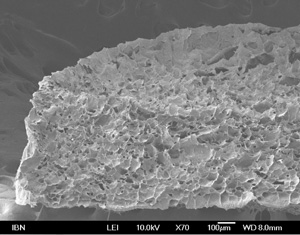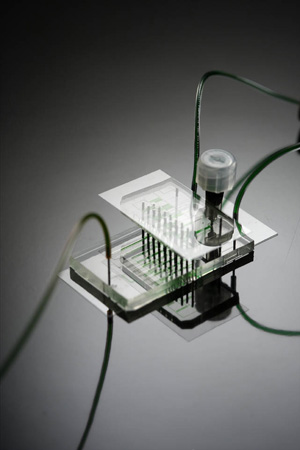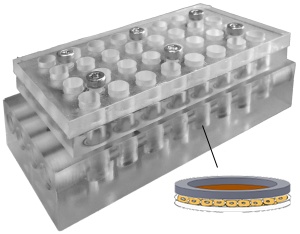Engineered artificial human livers for drug testing and discovery
March 18, 2013

IBN-Cellulosic-Scaffold (credit: IBN)
Institute of Bioengineering and Nanotechnology (IBN) researchers have engineered an artificial human liver that mimics the natural tissue environment closely.
The development makes it possible for companies to predict the toxicity of new drugs earlier, potentially speeding up the drug development process and reducing the cost of manufacturing.
The liver is an important target organ for drug testing because all drugs pass through it for detoxification. This is a process whereby harmful substances are reduced or removed from the body. Drugs that cannot be detoxified may cause poisoning or other lethal side effects.
IBN Executive Director Professor Jackie Y. Ying, said, “This research advance is the first drug testing model available that can sensitively predict long-term drug responses in the liver. Such predictive toxicology platforms are useful research tools that aid and accelerate the discovery of new drugs. The ability to determine drug toxicity at an early stage would lead to significant cost savings for the pharmaceutical companies and consumers.”
IBN Group Leader Professor Hanry Yu elaborated, “Most materials and devices have been designed with little attention to what the cells need. By using a cell-centered approach and translating our basic understanding of tissue behavior, we have developed liver tissue models that can simulate conditions outside the body with striking similarity to organs inside the body.”
IBN’s liver tissue models for drug toxicity testing comprise the following patented technologies:
Three-Dimensional Cellulosic Scaffold
Using hydroxypropyl cellulose, an FDA-approved plant-based material that is the basic building block of cotton and paper, IBN fabricated a biocompatible porous scaffold that enables liver cells to spontaneously assemble into three-dimensional liver spheroids. These spheroids strongly resemble liver tissue, hence facilitating drug testing. This technology was licensed in 2010 to Bio-Byblos Biomedical Co. Ltd, a biomedical company based in Taiwan, for manufacturing.

IBN HepaTox Chip (credit: IBN)
Liver-on-Chip
IBN’s innovative HepaTox chip is a “liver-on-chip” that allows researchers to test the effect of drugs on the liver. By seeding liver cells within a microfluidic system, the micro device is used to screen the liver’s capacity to process different drugs and other compounds.
The HepaTox chip features eight channels, which enable multiple drug screening in parallel. With miniaturization, the amount of liver cells and drugs can also be significantly reduced, saving cost without comprising efficiency.
Microporous Membrane Sandwich Culture
A typical drug screening platform requires liver cells for testing, and conventionally the cells are cultured within a collagen-based gel. However, the gel can trap drugs and limit access to nutrients and oxygen, leading to variable and inconsistent results.
Using IBN’s microfabricated microporous membrane, the liver cells are sandwiched between the membranes, which can control the transfer of drugs, nutrients and oxygen to the cells, and provide more reliable and reproducible screening results. The membrane surface has been engineered to simulate liver cell interaction with matrix and to promote formation of liver tissues after the cells are seeded.
Experiments have shown that the microporous membranes can maintain long-term liver cell functions for more than two weeks and will be useful for chronic liver toxicity testing, and industry-scale drug screening.
If commercialized, IBN’s liver tissue models can be developed into test kits to support drug development and pre-clinical research. In January this year, IBN collaborated with Janssen, a pharmaceutical company of Johnson & Johnson, to produce liver cells from human stem cells for drug testing.

IBN Microporous Membrane Sandwich Culture (credit: IBN)
This new research project leverages IBN’s expertise in liver tissue engineering to develop an alternative source of human liver cells, which are limited in supply. IBN is also working with global healthcare company Hoffman La-Roche on a new drug screening method for hepatitis viruses, which are leading causes of liver cancer.